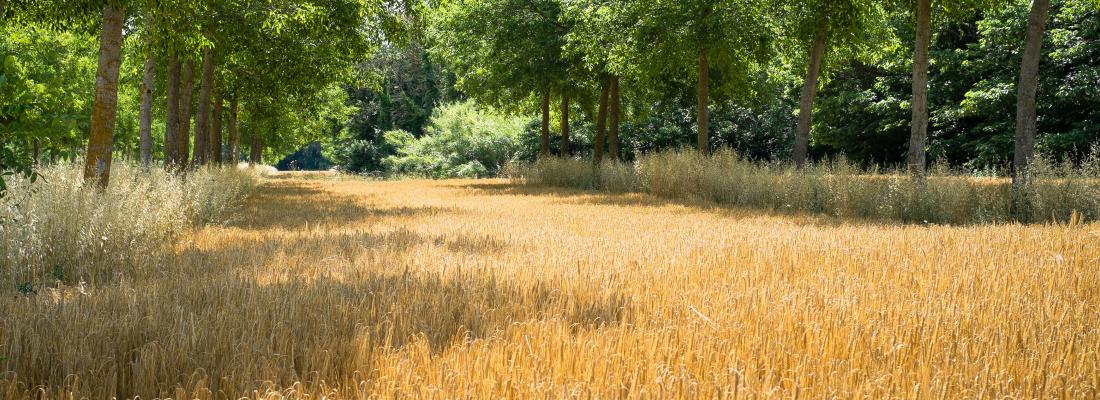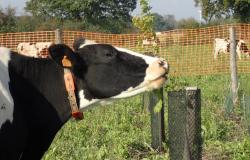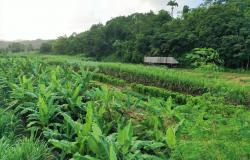Agroecology Reading time 10 min
Agroforestry: trees provide a way forward for sustainable farming
Published on 06 January 2022

Agroforestry can be defined as a dynamic management system for natural resources based on ecological principles which introduces trees into farms and the agricultural landscape, thereby facilitating a form of diversified and sustained production that improves social, economic and environmental conditions for all land users. (Sources: Ministère de l’agriculture et de l’alimentation, ICRAF).
The traditional forms of agroforestry seen in France are either bocage or orchard systems combining full-size fruit trees with pasture. More recently, this repertory has expanded to include either fruit trees or forest trees grown in association with pasture, arable crops or market gardening. Trees can be incorporated in the middle of an agricultural plot (known as intra-plot agroforestry) or along its margins (in the form of a hedgerow, for example). Alternatively, they are to be found as part of a forest or woodland where other plant products are harvested, or livestock is brought to graze (wood pasture). In the French overseas departments and territories, crops such as cocoa, coffee and vanilla are grown in the shade of trees, and the island gardens of the West Indies and Mayotte are richly diversified, their small plots filled with plant and animal species for home consumption (food, spices, wood, etc). Traditional swidden systems (itinerant cultivation using burn and fallow phases) operate in the forests of French Guyana, while elsewhere in the tropics the use of multi-layered agroforestry systems is widespread.
Agroforestry: systems beyond borders
A dehesa is a publicly owned form of wood pasture where grazing is carried out under low-density tree cover. This type of farming, known as montado in Portugal, is to be found in the Iberian Peninsula and the Maghreb, where it has been practised since the Middle Ages. The inclusion of pasture provides a way for community members to feed their animals, and they are able to harvest the natural products to be found on the woodland floor, in the understorey and from the trees themselves (cork-tree bark, for example).
First developed in Burma, taungya uses the interplanting of trees (teak in particular) with staple food crops and helps to restore damaged and depleted soils.
Agroforestry: vital statistics
The European AGFORWARD project (AGroFORestry that Will Advance Rural Development, 2014-2017), in which INRAE was involved as a partner, used the EUROSTAT LUCAS database to analyse land use and land cover in Europe, estimating that a total area of 15.4 million hectares was under agroforestry for the 27 countries then in the EU (3.6% of total area, 8.8% of utilised agricultural area (UAA)). Livestock agroforestry was revealed to be the most common type of agroforestry (15.1 million ha), far outstripping arable agroforestry (358,000 ha). Cluster analysis by country revealed clear differences: Spain has the greatest absolute extent of agroforestry (5.6 million ha), followed by Greece and France in equal second place (1.6 million ha). When the extent of agroforestry is calculated as a proportion of a country’s UAA, the southern countries of Europe dominate, with Cyprus in first place (40.1%), while France, at just 5.6%, drops back to 11th place.
The FAO Report on the State of the World’s Biodiversity for Food and Agriculture (2019) observed progress in agroforestry in many countries. Estimates for the 2008-2010 period stood at more than 5 million km2 with at least 20% tree cover, representing an increase of 1.8% since 2000.
The benefits of agroforestry
The creation of agroforestry plots exploits the complementary nature of trees, on the one hand, and crops or livestock farming on the other, improving use of environmental resources.
Agroforestry practices have already clearly demonstrated their value: run-off and soil erosion are reduced; soil ecosystems (microorganisms and macrofauna) and structures are improved, encouraging the availability of water and nutrients; habitats or corridors for the movement of many species (including auxiliary species useful for biological pest control) are provided and products (and thence revenue sources) at farm scale are diversified. In some cases, mixed farming increases overall productivity compared with monocultures because the ecological niches of the different species are complementary.
The 2019 IPCC Special Report on Climate Change and Land also identified agroforestry as an available potential lever to mitigate and adapt to climate-change, increase food security, and combat desertification and soil degradation. Because they increase soil organic matter and carbon sequestration, agroforestry systems have a particular role to play in achieving the worldwide ‘4 per 1000’ target.
Public policy: a slow-growing profile
In France, following the 2012 launch of the country’s agroecological programme, an agroforestry development plan (2015-2020) was produced under the aegis of the French Minister for Agriculture with a broad brief to consider all areas useful to its development. The plan sought to make provision for the sustainable management of all forms of agroforestry throughout the French territories and to be applicable to all their various agricultural systems. The programme underwent evaluation in the course of 2020, and is currently being renewed for the period 2021 – 2025.
At European scale, the CAP has only recently taken account of agroforestry. From 2006 onwards, agroforestry plots were recognised as agricultural parcels, thus becoming eligible for first and second pillar CAP funding up to a limit of 50 trees per hectare. In 2010, the maximum density was increased to 200 trees/ha. That year, the official publication of Measure 222 of the French Rural Development National Plan for mainland France (PDRH), implementing the European Rural Development Regulation (RDR) at national level, enabled financial support to be granted for the establishment of new agroforestry systems.
In the new CAP (2023-2027), agroforestry (or, more precisely, the presence of agroecological infrastructure features such as hedges, tree rows and isolated trees), occupies a relatively small place in the wider ‘eco-scheme’ system to fund environmentally friendly practices (activities related to climate, environment, animal welfare and anti-microbial resistance).
Make our planet treed again!
Agroforestry is often a central pillar in development programmes from the Global South, providing a way to support farmers’ living conditions, develop a form of agriculture that is adapted to climate change, preserve biodiversity, and restore soils. In May 2019, CIRAD and INRAE (then INRA) hosted the 4th World Congress on Agroforestry in Montpellier, which saw some 15,000 participants from more than a hundred countries come together over a week of events. At its close, participants called on public and private decision makers to introduce profound changes in governance, training and funding to accelerate the introduction of agroforestry systems, adopting the Montpellier Declaration under the banner, ‘Make our planet treed again!’
Branching out at INRAE’s research facilities
INRAE’s experimental sites: great opportunities for partnership
At the beginning of the 1990s, the research world was just beginning to investigate the beneficial presence of trees within agricultural plots in work pioneered by a handful of scientists. These included Christian Dupraz in Montpellier, who established the flagship project at the Restinclières experimental site (40 ha of arable agroforestry and vine agroforestry on land belonging to the Herault local administration). Next adding the bocage landscape around Rennes and sylvopastoralism in Provence-Alpes-Côte d’Azur to its portfolio of agroforestry sites, the Institute has continued to expand its work on this subject, with many INRAE teams now employed on a number of long-term agroforestry projects at its various facilities.
In the Nouvelle-Aquitaine region, in Lusignan, the Experimental Unit for Forage, Environment and Ruminants (FERLUS) has, since 2014, been using a mixed-crop-bovine dairy system to investigate innovative forage systems, such as the valorisation of woody fodder resources, or the introduction of trees to open pasture or arable fields to provide fodder, wood chip and timber. These agroforestry plots form part of the OasYs experimental network created by six INRAE research departments.

Cows grazing on trees. This is a new form of grazing that INRA has developed for dairy cattle based on grass, fodder… and the leaves of living trees.
Meanwhile, in Magneraud, the experimental platform run by the EASM unit, which investigates alternative poultry farming systems, has, since 2009, included a poultry run planted with trees covering 1 ha.
The many studies carried out in these facilities are supported by national, European and international projects.

In Petit-Bourg, two experimental facilities targeting small family agriculture apply agroecology principles against a backdrop of mixed crop and livestock production at one facility and bioeconomy at the other.
Research at the sites is also shaped by the scientific and technical partnerships created through mixed technological networks (RMTs in French). RMTs bring together researchers, trainers and developers working on priority areas for development in the agricultural and agri-food sectors, carrying out collaborative studies and promoting innovation. In the case of the AgroforesterieS RMT, of which INRAE is a founding member, the network links many stakeholders with expertise in agricultural and economic development, training, and production, working alongside units from INRAE and CIRAD. Its purpose is to pool the competences, skills and other contributions of the various partners in the development of technical and methodological tools to support the creation and management of agroforestry plots. INRAE also works in partnership with the Association Française d’Agroforesterie, formed in 2007.
What next?
Agroforestry, complex and heterogeneous systems that extend across space and through time
Agroforestry systems bear little resemblance to the visions of idealists or campaigners. The reality of these systems is that they are complex and heterogeneous, ranging in scale from agricultural plots to landscapes and constantly evolving through time.
Continued study of the organisation, functions and characteristics of agroforestry systems will be needed to tackle the particular issues that arise in the drive to develop them. How do we integrate trees into livestock systems? What are the dynamics of growth both above and below ground? What part do they play in water and nutrient cycles and can we model this? What are the benefits and constraints of agroforestry systems for farmers, landscapes and society? And what are the associated political and organisational challenges and levers?
In those systems that combine trees and crops, questions on competition for above-ground resources and the effects of underplanting on light interception have long been at the forefront of the research agenda.
These have now been joined by a host of other research questions. Considerable scientific interest has been shown in trees and their litany of associations (and hence interactions) with immediately-surrounding vegetated land (cultivated or not) or with neighbouring pasture and /or arable crops, including their relative share of underground resources and nutrients, their ecosystem and biodiversity functions, their part in major geochemical cycles, their contribution to the mitigation of climate change, and so on.
The DIAM’S platform: instrumented study of agroforestry in a Mediterranean climate with a restricted water supply
In the Hérault the DIAM’S digital platform, co-managed by a trio of INRAE units (Functional Ecology, Biochemistry of Soils and Agricultural Systems, and Diascope), is seeking to build systems offering a suite of ecosystem services in constrained climates and with low quality soils.
Agroforestry is central to this project, providing a beneficial and sustainable model for extended longitudinal study.
Our researchers are also looking further afield, to tropical agroforestry systems that are configured as multi-layered systems where plants are grown at different levels and each species plays a very specific role, bringing their collective expertise to bear on the possibility of adapting such systems to the needs of more temperate climates.
Among the projects where INRAE currently acts as either a coordinator or partner are:
- DSCATT, exploring soil carbon sequestration in agricultural systems as a potential means to combat the global changes to agriculture brought about by the climate emergency. Jointly financed by the Agropolis and Total Foundations (2019-2023), its chief purpose is to develop sustainable agricultural systems tailored for high productivity and accumulated carbon sequestration, and to raise awareness of the role of soil management in the mitigation of greenhouse gas (GHG) emissions. DSCATT is working in Africa and in France, operating on the three spatial scales of the field, the farm and the locality or village.
- AGROMIX (EU, 2021-2024), developing and testing existing mixed-agriculture and agroforestry models through participatory co-creation in order to increase their environmental and socio-economic resilience. Two of the project’s core agroforestry and mixed-agriculture trial sites are managed by INRAE. They integrate trees with, respectively, livestock and arable crops.
- MIXED (EU, 2021-2024), seeking to drive the development of European mixed farming and agroforestry systems that optimise efficiency and resource use, reduce GHG emissions and show greater resilience to climate change by considering agronomic, technical, environmental, economic and social advantages and constraints.
- MIXROOT-C (EU, 2021 – 2024), set up to carry out in situ measurements of the carbon (C) produced by roots, and to identify the root traits associated with soil organic C storage in the arable and subsoil layers found in the diversified agricultural systems typical to Europe (e.g., interplanted crops, or pasture and agroforestry).
